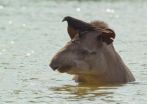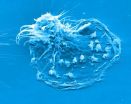(Press-News.org) Alexandria, VA – Throughout history, humanity has steadily increased its dependence upon technology. Although technology has vastly improved the quality of life for billions of people, it has also opened us up to new risks and vulnerabilities. Terrorism and natural disasters might be at the forefront of the minds of policymakers and the U.S. population, but a significant threat lurks over our heads: the sun. A massive solar storm, the size last seen a century and a half ago, could easily leave hundreds of millions of people in the dark for days, weeks or even months.
The sun follows a roughly 11-year cycle of activity, measured by the number of sunspots on its surface. The solar maximum – when sunspot activity peaks, with a corresponding increase in solar flares and billion-ton blobs of magnetic field-generating solar plasma known as coronal mass ejections (CMEs) launched from the sun's surface – is forecast to occur later this year. How would the power grid, fuel pipelines, communication, and water treatment plants be affected were a massive solar storm to strike Earth? Read the story online and find out at http://bit.ly/106mE7a.
###
Check out this story and more in the February issue of EARTH Magazine. Learn how a magma aquifer might link Hawaiian volcanoes; see how cataclysmic celestial collisions created beautiful meteorites; and discover an ancient ancestor of the giant panda all the way in Spain in this month's issue of EARTH.
Keep up to date with the latest happenings in Earth, energy and environment news with EARTH magazine online at http://www.earthmagazine.org/. Published by the American Geosciences Institute, EARTH is your source for the science behind the headlines.
The American Geosciences Institute is a nonprofit federation of geoscientific and professional associations that represents more than 250,000 geologists, geophysicists and other earth scientists. Founded in 1948, AGI provides information services to geoscientists, serves as a voice of shared interests in the profession, plays a major role in strengthening geoscience education, and strives to increase public awareness of the vital role the geosciences play in society's use of resources, resiliency to natural hazards, and interaction with the environment. END
EARTH: The dangers of solar storms
2013-01-22
ELSE PRESS RELEASES FROM THIS DATE:
Unprecedented glacier melting in the Andes blamed on climate change
2013-01-22
Glaciers in the tropical Andes have been retreating at increasing rate since the 1970s, scientists write in the most comprehensive review to date of Andean glacier observations. The researchers blame the melting on rising temperatures as the region has warmed about 0.7°C over the past 50 years (1950-1994). This unprecedented retreat could affect water supply to Andean populations in the near future. These conclusions are published today in The Cryosphere, an Open Access journal of the European Geosciences Union (EGU).
The international team of scientists – uniting researchers ...
How can evolutionary biology explain why we get cancer?
2013-01-22
Over 500 billion cells in our bodies will be replaced daily, yet natural selection has enabled us to develop defenses against the cellular mutations which could cause cancer. It is this relationship between evolution and the body's fight against cancer which is explored in a new special issue of the Open Access journal Evolutionary Applications.
"Cancer is far from a single well-defined disease which we can identify and eradicate," said Dr Athena Aktipis, Director, Human and Social Evolution, Center for Evolution and Cancer at the University of California, San Francisco. ...
Children with egg allergies can safely receive flu vaccine, U-M study says
2013-01-22
Ann Arbor, Mich. — Egg allergic children, including those with a history of anaphylaxis to egg, can safely receive a single dose of the seasonal influenza vaccine, according to a new study from the University of Michigan.
Historically, the CDC recommended that the seasonal influenza vaccine not be administered to egg allergic children. Recent research conducted at the University of Michigan, and elsewhere, helped modify this recommendation in 2011 so that caution was warranted for only those with severe egg allergy.
The new study, published in the Annals of Allergy, ...
Hypertension during pregnancy increases risk of end-stage renal disease
2013-01-22
Women with hypertensive disorders in pregnancy are at higher risk of chronic kidney disease and end-stage renal disease compared with women without the disorders, according to a study in CMAJ (Canadian Medical Association Journal).
"We found that women with hypertensive disorders during pregnancy were at higher risk of end-stage renal disease than women without complicated pregnancies," writes Dr. I-Kuan Wang, Division of Nephrology, China Medical University Hospital, Taichung, Taiwan, with coauthors.
Hypertensive disorders such as gestational hypertension and preeclampsia ...
Antibacterial agent used in common soaps found in increasing amounts in freshwater lakes
2013-01-22
When people wash their hands with antibacterial soap, most don't think about where the chemicals contained in that soap end up. University of Minnesota engineering researchers do.
A new University of Minnesota study determined that the common antibacterial agent, called triclosan, used in soaps and many other products is found in increasing amounts in several Minnesota freshwater lakes. The findings are directly linked to increased triclosan use over the past few decades.
In addition, the researchers found an increasing amount of other chemical compounds, called chlorinated ...
Paradise found for Latin America's largest land mammal
2013-01-22
NEW YORK (January 22, 2012) —Wildlife Conservation Society scientists have documented a thriving population of lowland tapirs – the strange forest and grassland-dwelling herbivore with the trunk-like snout – living in a network of remote national parks spanning the Peru-Bolivia border.
Using a combination of camera traps, along with interviews with park guards and subsistence hunters, WCS estimates at least 14,500 lowland tapirs in the region. The population bridges five connected national parks in northwest Bolivia and southeastern Peru.
The WCS findings were described ...
Immune system molecule with hidden talents
2013-01-22
This press release is available in German.
Dendritic cells, or DCs for short, perform a vital role for the immune system: They engulf pathogens, break them down into their component parts, and then display the pieces on their surface. This in turn signals other immune cells capable of recognizing these pieces to help kick-start their own default program for fighting off the invaders. In order to do their job, the DCs are dependent upon the support from a class of immune system molecules, which have never before been associated with dendritic cells: antibodies, best ...
New research on military traumatic brain injury
2013-01-22
Philadelphia, Pa. (January 22, 2013) – Researchers are making new strides in understanding the health consequences and treatment and rehabilitation needs of combat veterans and other service members affected by traumatic brain injury (TBI). The January-February issue of The Journal of Head Trauma Rehabilitation, official journal of the Brain Injury Association of America, is a special issue devoted to new research in military TBI. The journal is published by Lippincott Williams & Wilkins, a part of Wolters Kluwer Health.
"For the second consecutive year, we've expedited ...
New information on binding gold particles over metal oxide surfaces
2013-01-22
The strong binding of gold on electronically modified calcium oxide can now be understood in detail. In a computational study, researchers Jenni Andersin, Janne Nevalaita, Karoliina Honkala and Hannu Häkkinen at the University of Jyväskylä Nanoscience Center have shown how redox chemistry entirely determines the adsorption strength of gold on the modified oxide where one metal atom is replaced with molybdenum. The study was funded by the Academy of Finland.
The research team applied the so-called Born-Haber cycle to analyse how different terms contribute to adsorption ...
The Nurse Practitioner marks 25th Annual Legislative Update
2013-01-22
Philadelphia, Pa. (January 22, 2013) – The most comprehensive review of new legal and regulatory issues affecting advanced nursing practice across the United States is now available in the "25th Annual Legislative Update," presented exclusively by The Nurse Practitioner: The American Journal of Primary Healthcare. The Nurse Practitioner is published by Lippincott Williams & Wilkins, a part of Wolters Kluwer Health.
Compiled by Susanne J. Phillips, MSN, FNP-BC, the annual supplement presents a comprehensive review of the legislative proceedings, bills, and laws pertaining ...



